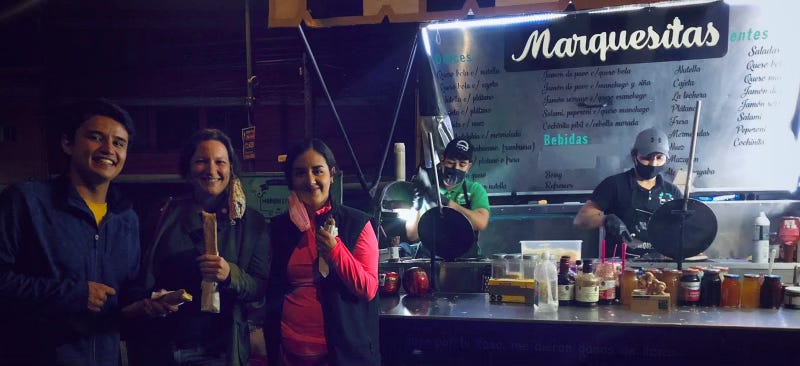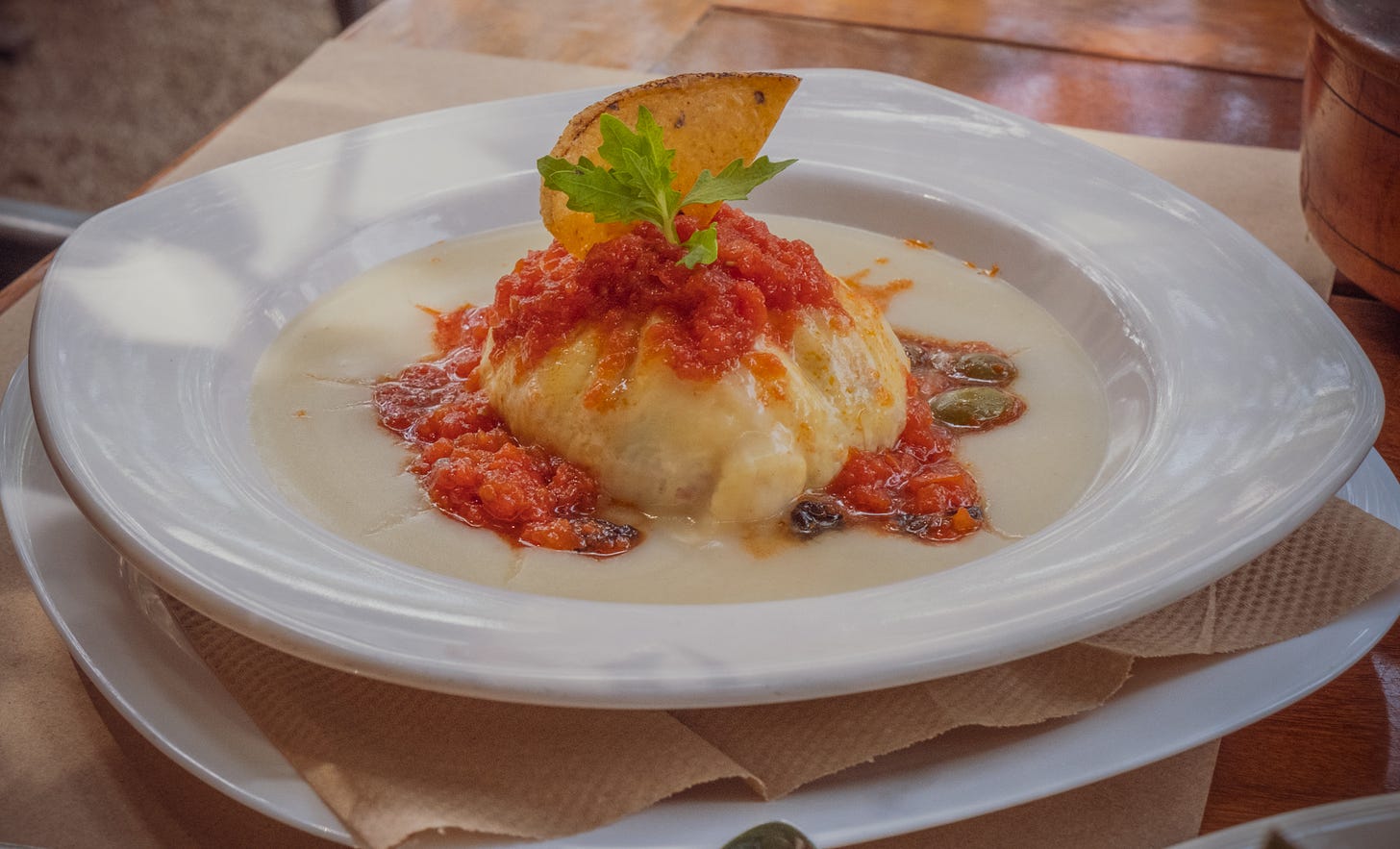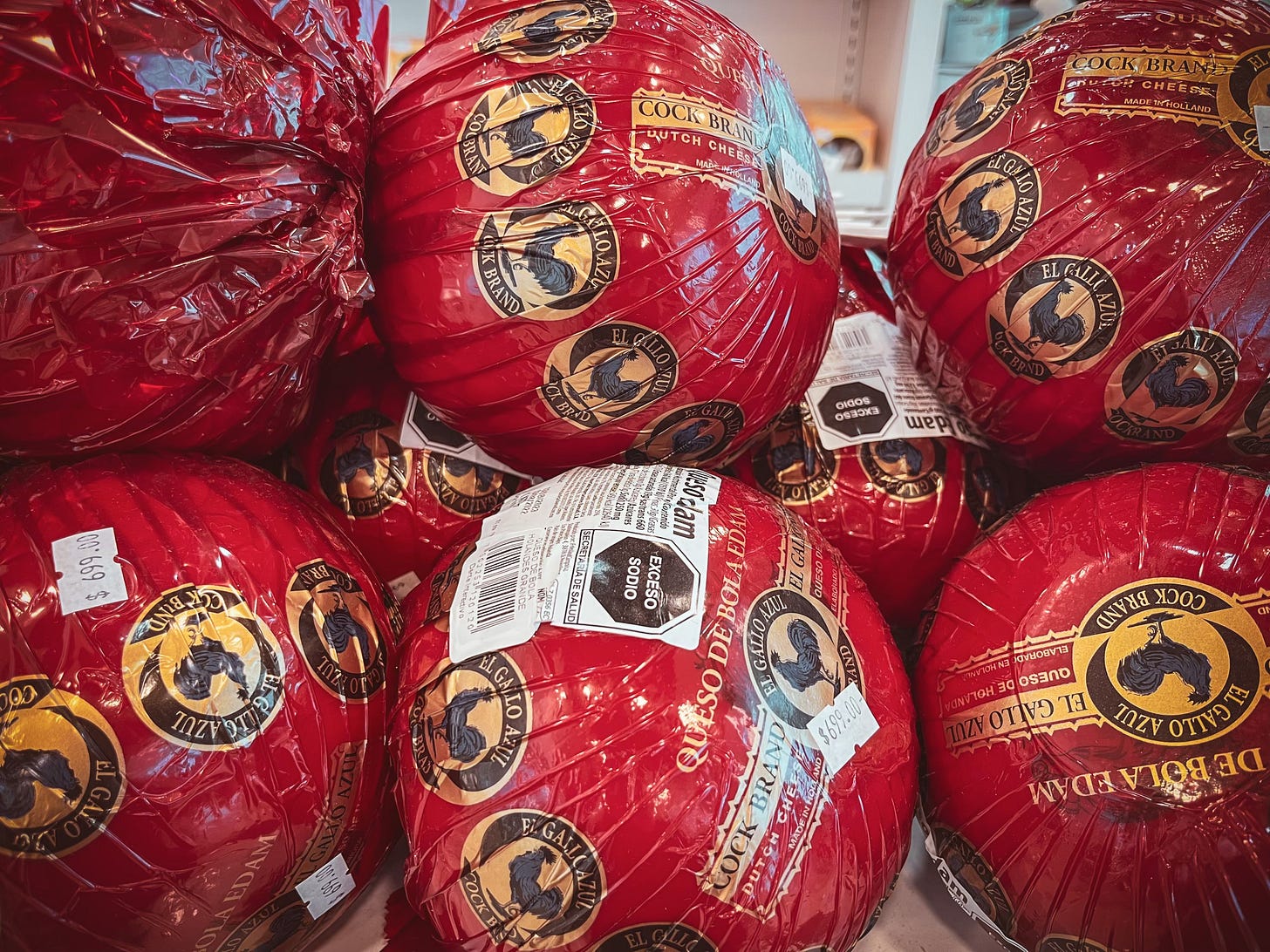The Yucatán’s Love Affair with Edam Cheese
An unexpected encounter in Mexico City leads to a trip to Mérida and a better understanding of the Dutch import's outsize presence in the Yucatán Peninsula
Last January my friends Bernardo and Valeria took me out for a night that ended at “Las Hijas de Marqués,” a popular food truck in Mexico City’s Colonia del Valle neighborhood. It sells a classic Yucatán treat called a marquesita. Crepe-like batter is cooked on a griddle until it forms a crisp, thin wafer which is then stuffed with sweet and/or savory fillings. Rolled up and served in a napkin, it’s the ultimate street food.
This particular stand offered more than 50 combinations of fillings: traditional crepe ingredients (fruit jams, Nutella, bananas, strawberries) and savory preparations such as cochinita pibil, but nearly everyone’s order included shavings from softball-sized orbs of cheese wrapped in red cellophane. Bernardo informed me it was queso de bola (ball cheese) and insisted I try it; after all, he explained, a marquesita wasn’t really a marquesita without this key component. And he urged me to pair it with a sweet filling, so I opted for dulce de leche.
I must admit I found the cheese unappealing. It was too aggressively salted for my taste and it didn’t melt into a luxurious pool like Gruyère or Comté in a French crepe. Even after time inside the hot iron, the cheese remained brittle and waxy, like the pre-shredded “parmesan” available in US grocery stores. I didn’t really care for the taste and texture, however, I was eager to know more about this ingredient.
A quick, one-handed Google search (while trying to prevent the grated cheese from spilling out of my marquesita) indicated that queso de bola was the name for Edam, a popular cheese from the Netherlands. How did a Dutch import become an essential element of this quintessentially Yucatecan snack?
Bernardo and Vale insisted we finish our marquesitas in their car because it was too cold outside for my Chilango friends (it was a balmy 65 degrees to this Chicagoan). As soon as I sat down, the dulce de leche seeped out of the crispy wrapper and poured all over my jacket, my jeans and—to my mortification—the backseat of Bernardo and Vale’s car. It even found its way inside my seat belt buckle and into the fold where the seat and the backrest meet. It was everywhere. Even though my friends were unbelievably gracious, I was completely horrified. I returned home that night and blocked the marquesita experience out of my mind, quashing my desire to do any further research on the history of queso de bola.
Fast forward to December 2022. Back home in Chicago and longing for Mexico, I found myself binging Season 11 of Rick Bayless’ Mexico: One Plate at a Time, “Yucatan: A Different Mexico.” In the second episode Bayless meets up with Chef Miriam Peraza, who leads him on a tour of Mérida’s Mercado de Lucas Galvez and then brings him into the kitchen of Manjar Blanco, her temple to traditional Yucatecan cooking. And there it was before me: queso de bola.
It was that same ball of cheese, encased in red wax and wrapped in red cellophane. But what Chef Miriam did with the cheese completely blew my mind.
Rather than shredding it, she scooped out the center of the ball and made a filling from ground pork, assorted spices, chopped raisins, capers, olives, almonds, chilies, onions and tomatoes. She stuffed this mixture into the hollow ball, wrapped the entire thing in cheesecloth and set it over simmering water. Once the cheesy exterior became tender, she cut a wedge, placed it in a serving bowl and dressed it with a sauce made from chicken stock and thickened corn masa as well as a fresh tomato sauce with caper and olives.
I immediately booked tickets to Mérida for a week in March. I had to try this dish.
—
The version of queso relleno (literally: stuffed cheese) that Chef Miriam demoed on TV featured the standard size ball of cheese, which is 14 centimeters in diameter and weighs in at a whopping 1.75 kilograms (approximately 3.85 pounds).
Since it takes a single family several months to make it through an entire ball of Edam, not to mention the effort required to prepare the elaborate dish, queso relleno is often reserved for special occasions. The stuffed cheese is presented on a platter with the two sauces served separately. The guest of honor or head of the family receives the first wedge, as with a birthday cake, then adds to it the desired portion of white and red sauces, customizing the flavor profile of the finished dish.
The version I sampled at Chef Miriam’s Manjar Blanco was modified for restaurant consumption. A molten ball of cheese, closer in size to a tennis ball than to a slow-pitch softball, sat in the center of a flattened soup bowl. It was dressed with a fire-engine red relish that also pooled in the white sauce below. This tomato sauce, punctuated by whole green olives and black raisins, bled into the white gravy and formed tendrils, like those I remember creating with a Spirograph set as a child.
I paused to marvel at the complexity of the dish I was about to consume. Before cutting into the cheese, I first dragged my spoon through the sauces. Though similar in appearance to a béchamel, the white gravy was faintly redolent of corn with a subtle chicken flavoring. The tomato sauce was screaming in comparison—the brightness of the barely-cooked tomato combined with the salty tang of the olives and the sweetness of the plumped raisins.
Once I cut into the cheese, the pork filling spilled out and revealed its jeweled interior. I could smell the warm spices, primarily black pepper and nutmeg, used to season the picadillo. I took my first bite. The mincemeat was at once tender and subtly-spiced yet the bits of caper and olives packed a bold punch and the almond added a necessary crunch. I originally mistook the raisins for chunks of dried prunes; these were much earthier and juicier than the leathery, flavorless raisins I recall from childhood.
The cheese was that same funky tasting Edam I had sampled in the marquesita, however its extreme saltiness was tempered by being paired with the pork filling and sauces. I was expecting the cheese to be completely melted all the way through, but its interior had a slightly pliant consistency, a nice contrast in texture.
I received handmade tortillas as an accompaniment, but I was happy luxuriating in the queso relleno itself. It reminded me of eating Thanksgiving dinner, a mix of turkey, stuffing, cranberry sauce, mashed potatoes and gravy before me; each forkful a unique combination of flavors.
—
Many Yucatecans regard queso relleno as the apex of Yucatecan gastronomy, even more so than the popular cochinita pibil. A close consideration of the dish reveals why it is so prized—as you start examining the various components, layers of history, cultural admixture and culinary innovation stare back at you from the plate.
The Cheese
The Dutch West India Company (founded in 1621) came to the Yucatán peninsula in an attempt to establish Dutch colonies, as well as to trade with the Spanish and French. They brought with them Edam cheese, which was popular at sea and in the New World colonies because it does not spoil, it simply becomes harder and develops a bolder flavor as it ages. While the Dutch were not successful in colonizing the Yucatán peninsula, the popularity of Edam cheese lives on.
The popularity of this pantry item is so widespread that it can be found in savory preparations like empanadas and salbutes but also in sweets: there is queso de bola ice cream, flan, cake and donuts. It also serves as a savory foil for papaya, which is boiled in burnt sugar and honey to the point of being tooth-achingly sweet. As Chef Miriam explained to Cecilia García Olivieri for Yucatán Today:
The wonder of Queso de Bola is that it accentuates all flavors, whether salty or sweet. You feel its bold flavor, but at the same time it gives way to an exquisite mix for the palate.
The most recognizable brand today is El Gallo Azul (its label stamped with an eponymous blue rooster). It is found in markets and gas stations across the Yucatán Peninsula and is a common gift brought back by Mexicans returning to other parts of the country, a symbol of the Yucatán itself.
The Filling
The pork is another direct result of European influence. It was Spanish conquistadors who introduced several types of pigs—Celtic pigs (Sus celticus) from the European boar family, Iberian pigs (Sus mediterraneus) and Asian pigs (Sus vittatus)—to the region. Enthusiastically adopted by the Maya, today pork (from nose to tail and everything in between) is an indispensable component of Yucatecan cooking. It’s not just cochinita pibil, but also lechon asado, poc-chuc, puerco y frijol…the list goes on).
The capers, olives and raisins that stud the pork filling also speak to the dish’s Spanish influence. The Spaniards, who had been introduced to these ingredients by the Moors during their reign of El-Andalus, brought these items to the New World in their ships’ holds. Known collectively as alcaparrado (which means “capered”), these sweet and savory components lend a tangy flavor profile that speaks to the various iterations of conquest and complexity embodied by this dish.
The Sauce
This is where two ingredients endemic to the Yucatán Peninsula and essential to Yucatecan cooking make an appearance: maize and tomato. The white sauce surrounding the stuffed ball of cheese is a Maya porridge called sak k’ool. Translated as “thick white soup,” it is a combination of stock (in this case chicken) mixed with masa (nixtamalized corn dough). The red sauce is a bright cooked tomato sauce (tomate frito) that pre-dates the Spanish invasion.
The Finished Dish
No one knows exactly how queso relleno came to be—there are stories of laborers on henequen farms salvaging the discarded rinds (after prosperous land owners consumed the cheese) and stuffing them with vegetables—but the dish speaks to adaptation and creativity. On a single plate we find Spanish, Arab, Dutch and Maya influences and yet it’s the innovative combination of these elements, and the affection for this hard, salty cheese, that makes queso relleno insistently Yucatecan.
During our weeklong trip to Mérida I noticed queso relleno on several restaurant menus and saw unrefrigerated balls of Edam at various market stands. While I steered clear of the numerous marquesita stands that line Mérida’s Parque Santa Ana in the evenings and surround the city’s Plaza Grande during its weekly Mérida en Domingo festivities, I was pleased to know why these stalls were lined with balls of Edam cheese. It may not be my snack of choice, but I certainly have a stronger appreciation for the history of queso de bola and its place in Yucatecan gastronomy.
Postscript
As I was putting the finishing touches on this post last night, a CNN video appeared in my newsfeed featuring Eva Longoria with the owner of Kinich, a restaurant in Izamal, Yucatán, demonstrating the most popular dish on her menu: queso relleno as part of Longoria’s new program, “Searching for Mexico.” So I guess the word’s out!







